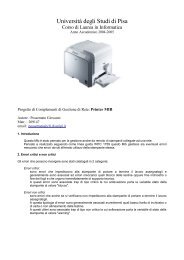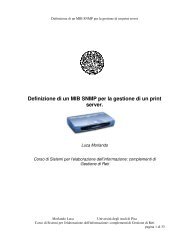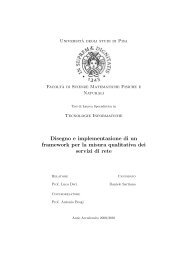vPF_RING: Towards Wire-Speed Network ... - Luca Deri - Ntop
vPF_RING: Towards Wire-Speed Network ... - Luca Deri - Ntop
vPF_RING: Towards Wire-Speed Network ... - Luca Deri - Ntop
You also want an ePaper? Increase the reach of your titles
YUMPU automatically turns print PDFs into web optimized ePapers that Google loves.
Gigabit tests we have used a home-grown tool named<br />
pfsend with PF_<strong>RING</strong> DNA (Direct NIC Access) [47] for<br />
reproducing traffic at wire speed previously captured on a<br />
network backbone. This has allowed us to test <strong>vPF</strong>_<strong>RING</strong><br />
under various conditions and with both synthetic and real<br />
network traffic. For the tests described later on this section,<br />
have been used forged packets in order to evaluate this<br />
work with different packet rates and sizes.<br />
The performance of <strong>vPF</strong>_<strong>RING</strong> has been compared with<br />
the performance of native PF_<strong>RING</strong> 4.6.x running on a<br />
physical (non virtualized) host and PF_<strong>RING</strong> running on a<br />
virtual KVM environment (using the VirtIO-Net support<br />
with the VHost-Net optimization). <strong>vPF</strong>_<strong>RING</strong> performance<br />
has also been positionedagainst VMware ESXi (using<br />
VMXNET 3, the latest version available of the VMware<br />
paravirtualized network device). All the VMs used during<br />
the evaluation have a single-core virtual CPU and also run<br />
Linux kernel version 2.6.36.<br />
The device driver used on the server on the host-side is the<br />
igb, developed by Intel, which is included in the Linux<br />
kernel. It is worth to remark that, although PF_<strong>RING</strong><br />
supports PF_<strong>RING</strong>-aware optimized drivers to bypass the<br />
standard operating system’s mechanisms, we decided not to<br />
use them in order to evaluate our work on the worst case<br />
(i.e. without any packet capture acceleration exploiting<br />
specific network cards features). This is because we want<br />
to compare native VirtIO-Net agains <strong>vPF</strong>_<strong>RING</strong>, without<br />
accounting any <strong>vPF</strong>_<strong>RING</strong> performance benefit due to<br />
these optimized drivers.<br />
Before describing the evaluating results, it is important to<br />
understand how the packet size affects the benchmarks.<br />
This parameter is relevant because the maximum packet<br />
rate that can be injected on a link depends on the packet<br />
size. As shown in Table 1, at wire-rate, small packet sizes<br />
corresponds tohigher packet rates. The packet capture<br />
performance is affected by the packet rate, which can be as<br />
high as 1.4 Million of packets per seconds (Mpps) when<br />
the packet size is 64 bytes (minimum packet size) on<br />
Gigabit links, 14.880 Mpps on 10 Gigabit.<br />
Line<br />
<strong>Speed</strong><br />
Table 1. Maximum Packet Rates<br />
64<br />
Byte<br />
Rates Per Frame Size (Kpps)<br />
128<br />
Byte<br />
256<br />
Byte<br />
512<br />
Byte<br />
1024<br />
Byte<br />
1 Gigabit 1488 844 452 234 119<br />
10 Gigabit 14880 8445 4528 2349 1197<br />
Another aspect worth to mention, is that with <strong>vPF</strong>_<strong>RING</strong> it<br />
is possible to use efficient packet filtering techniques<br />
within the host (in kernel-space or even in hardware), to<br />
further increase the performance. In fact, through the<br />
efficient communication channel provided by the vNPlug-<br />
CTRL component, <strong>vPF</strong>_<strong>RING</strong> is capable to instrument the<br />
PF_<strong>RING</strong> module for setting a variety of efficient filters.<br />
However, as we are interested in evaluating our work in the<br />
worst case scenario, packet filtering has not been used.<br />
Benchmarks have been done using pfcount, a simple packet<br />
capture application implemented on top of the PF_<strong>RING</strong><br />
API. The application captures packets, updates some<br />
statistics, and then discards packets without doing any<br />
further processing.<br />
In the first test we evaluate the packet capture performance<br />
when a single instance of pfcount processes the traffic<br />
injected at wire rate with different packet sizes on a single<br />
Gigabit link.<br />
Packet Rate (Kpps)<br />
1500<br />
1000<br />
500<br />
0<br />
64 128 256 512 1024<br />
Packet Size (Bytes)<br />
Virtual PF_<strong>RING</strong> Virtio-Net VhostNet<br />
Native PF_<strong>RING</strong> Generated traffic<br />
ESXi VMXNET 3<br />
Figure 11. Packet Capture Rate (1 Gbit)<br />
In Figure 11 we show that <strong>vPF</strong>_<strong>RING</strong>, similar to PF_<strong>RING</strong><br />
on a native environment, is able to process packets at wirerate<br />
(without packet loss), for every packet size, up to the<br />
maximum rate (1.488 Mpps per port).<br />
From the same figure we can observe that by using<br />
PF_<strong>RING</strong> in a virtual environment with the VirtIO-Net<br />
support (i.e. without the assistance of our framework), it is<br />
possible to efficiently capture without packet loss only<br />
medium/large packets, when packet rates are not more than<br />
a few hundred Kpps. In fact, with small packets severe<br />
packet drops can be observed. Results are slightly better<br />
when using PF_<strong>RING</strong> on a VMware ESXi virtual<br />
environment, but we can still notice severe packet drops for<br />
high rates.






